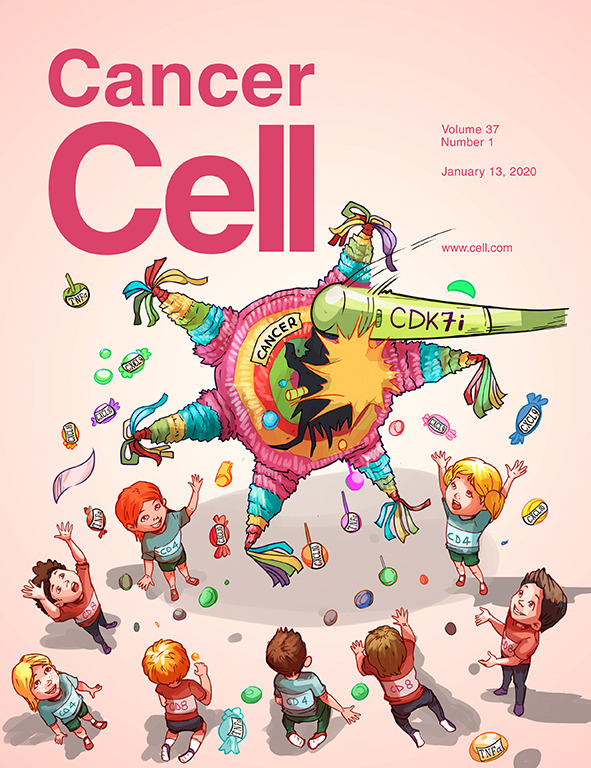突变负荷和抗PD-1结果并非普遍与免疫细胞浸润或淋巴细胞活化有关
IF 48.8
1区 医学
Q1 CELL BIOLOGY
引用次数: 0
摘要
章节片段正文 癌症通常被分为 "热 "肿瘤和 "冷 "肿瘤。"热 "肿瘤与高肿瘤突变负荷(TMB)和肿瘤浸润免疫细胞有关,而 "冷 "肿瘤则与缺乏新抗原和免疫细胞排斥有关。这种二分法经常被用来定义肿瘤微环境中预先存在的免疫细胞反应程度,并与临床结果(包括免疫检查点抑制剂(ICI)治疗的疗效)相关联。资助者在研究设计、数据收集和分析、决定发表或撰写手稿方面均未参与。作者在这项工作中未获得任何专项资助。作者贡献D.H.和H.Z.构思了这项研究。D.H.、A.E.和 J.X. 进行了数据分析。D.H.、A.S.、W.E.-D.、E.S.A.、S.L.G.、M.J.H.、H.B.、D.S.B.H.、S.V.L.、P.C.M.、R.R.M.、T.W.-D.、J.M.、G.W.S.、D.S.和 H.Z. 参与了 CARIS 队列的组建。D.H.起草了本文,所有作者都参与了稿件的审阅和编辑。利益声明A.E.、J.X.、G.W.S、S.L.G.担任辉瑞、第一三共、礼来、阿斯利康、基因泰克、SeaGen、诺华和梅纳里尼的有偿顾问/咨询师,并持有 HCA Healthcare 的股票。担任 Janssen、Astellas、Sanofi、Dendreon、Bayer、BMS、Amgen、Constellation、Blue Earth、Exact Sciences、Invitae、Curium、Pfizer、Merck、AstraZeneca、Clovis 和 Eli Lilly 的有偿顾问/咨询师;曾获得研究支持(至其本人本文章由计算机程序翻译,如有差异,请以英文原文为准。
Mutation burden and anti-PD-1 outcomes are not universally associated with immune cell infiltration or lymphoid activation
Section snippets
Main text
Cancers are conventionally classified as “hot” tumors that are associated with high tumor mutation burdens (TMBs) and tumor-infiltrating immune cells or “cold” tumors associated with a dearth of neoantigens and immune cell exclusion.1 This dichotomy is frequently used to define the degree of pre-existing immune cell reactivity within the tumor microenvironment and has been linked to clinical outcomes including the efficacy of immune checkpoint inhibitor (ICI) treatment.1 Recently,Acknowledgments
D.H. is supported by a Cancer Prevention and Research Institute of Texas Early Clinical Investigator Award (RP200549) and the Josephine Hughes Sterling Foundation. The funders had no role in study design, data collection and analysis, decision to publish, or preparation of the manuscript. The authors received no specific funding for this work.Author contributions
D.H. and H.Z. conceived the study. D.H., A.E., and J.X. performed data analyses. D.H., A.S., W.E.-D., E.S.A., S.L.G., M.J.H., H.B., D.S.B.H., S.V.L., P.C.M., R.R.M., T.W.-D., J.M., G.W.S., D.S., and H.Z. contributed to the assembly of the CARIS cohort. D.H. drafted the paper, and all authors participated in the review and editing of the manuscript.Declaration of interests
A.E., J.X., G.W.S., and D.S. are employees of Caris Life Sciences.S.L.G. serves as a paid consultant/advisor to Pfizer, Daiichi Sankyo, Eli Lilly, AstraZeneca, Genentech, SeaGen, Novartis, and Menarini and has stock ownership in HCA Healthcare.E.S.A. serves as a paid consultant/advisor to Janssen, Astellas, Sanofi, Dendreon, Bayer, BMS, Amgen, Constellation, Blue Earth, Exact Sciences, Invitae, Curium, Pfizer, Merck, AstraZeneca, Clovis, and Eli Lilly; has received research support (to his求助全文
通过发布文献求助,成功后即可免费获取论文全文。
去求助
来源期刊

Cancer Cell
医学-肿瘤学
CiteScore
55.20
自引率
1.20%
发文量
179
审稿时长
4-8 weeks
期刊介绍:
Cancer Cell is a journal that focuses on promoting major advances in cancer research and oncology. The primary criteria for considering manuscripts are as follows:
Major advances: Manuscripts should provide significant advancements in answering important questions related to naturally occurring cancers.
Translational research: The journal welcomes translational research, which involves the application of basic scientific findings to human health and clinical practice.
Clinical investigations: Cancer Cell is interested in publishing clinical investigations that contribute to establishing new paradigms in the treatment, diagnosis, or prevention of cancers.
Insights into cancer biology: The journal values clinical investigations that provide important insights into cancer biology beyond what has been revealed by preclinical studies.
Mechanism-based proof-of-principle studies: Cancer Cell encourages the publication of mechanism-based proof-of-principle clinical studies, which demonstrate the feasibility of a specific therapeutic approach or diagnostic test.
 求助内容:
求助内容: 应助结果提醒方式:
应助结果提醒方式:


